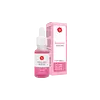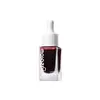What's inside
What's inside
 Key Ingredients
Key Ingredients

 Benefits
Benefits

 Concerns
Concerns

 Ingredients Side-by-side
Ingredients Side-by-side

Water
Skin ConditioningGluconolactone
Skin ConditioningButylene Glycol
HumectantGlycolic Acid
BufferingPentylene Glycol
Skin ConditioningPEG-40 Hydrogenated Castor Oil
EmulsifyingBetaine
HumectantSodium Citrate
BufferingPolyacrylate Crosspolymer-6
Emulsion StabilisingSalicylic Acid
MaskingSodium Hydroxide
BufferingPhenoxyethanol
PreservativeAllantoin
Skin ConditioningHydrolyzed Jojoba Esters
Skin ConditioningXanthan Gum
EmulsifyingAloe Barbadensis Leaf Juice
Skin ConditioningTriethylene Glycol
MaskingCI 14720
Cosmetic ColorantCI 42090
Cosmetic ColorantCI 19140
Cosmetic ColorantWater, Gluconolactone, Butylene Glycol, Glycolic Acid, Pentylene Glycol, PEG-40 Hydrogenated Castor Oil, Betaine, Sodium Citrate, Polyacrylate Crosspolymer-6, Salicylic Acid, Sodium Hydroxide, Phenoxyethanol, Allantoin, Hydrolyzed Jojoba Esters, Xanthan Gum, Aloe Barbadensis Leaf Juice, Triethylene Glycol, CI 14720, CI 42090, CI 19140
Water
Skin ConditioningGlycerin
HumectantGlycereth-26
HumectantGlycolic Acid
BufferingPEG-12 Dimethicone
Skin ConditioningPolysorbate 20
EmulsifyingNiacinamide
SmoothingPEG/PPG-17/6 Copolymer
SolventDipropylene Glycol
HumectantLactic Acid
BufferingAloe Barbadensis Leaf Water
MaskingPotassium Hydroxide
BufferingPEG-40 Hydrogenated Castor Oil
EmulsifyingPhenoxyethanol
PreservativeCitric Acid
BufferingHydroxypropyl Cyclodextrin
MaskingSalicylic Acid
MaskingCellulose Gum
Emulsion StabilisingPolyacrylate Crosspolymer-6
Emulsion StabilisingXanthan Gum
EmulsifyingInositol
Humectant1,2-Hexanediol
Skin ConditioningBeta Vulgaris Root Extract
Skin ConditioningDipeptide-15
Skin ConditioningHydroxyacetophenone
AntioxidantParfum
MaskingBrassica Oleracea Acephala Leaf Extract
HumectantMaltodextrin
AbsorbentGluconolactone
Skin ConditioningO-Cymen-5-Ol
AntimicrobialEthylhexylglycerin
Skin ConditioningButylene Glycol
HumectantPolyquaternium-51
Skin ConditioningPentylene Glycol
Skin ConditioningBeta-Glucan
Skin ConditioningHydrogenated Lecithin
EmulsifyingZinc PCA
HumectantSodium Hyaluronate
HumectantFomes Officinalis Extract
Skin ProtectingPropanediol
SolventCentella Asiatica Leaf Extract
Skin ConditioningSodium Lactate
BufferingPaeonia Albiflora Root Extract
Skin ConditioningSucrose
HumectantUrea
BufferingSodium Citrate
BufferingTartaric Acid
BufferingMalic Acid
BufferingQuaternium-73
Water, Glycerin, Glycereth-26, Glycolic Acid, PEG-12 Dimethicone, Polysorbate 20, Niacinamide, PEG/PPG-17/6 Copolymer, Dipropylene Glycol, Lactic Acid, Aloe Barbadensis Leaf Water, Potassium Hydroxide, PEG-40 Hydrogenated Castor Oil, Phenoxyethanol, Citric Acid, Hydroxypropyl Cyclodextrin, Salicylic Acid, Cellulose Gum, Polyacrylate Crosspolymer-6, Xanthan Gum, Inositol, 1,2-Hexanediol, Beta Vulgaris Root Extract, Dipeptide-15, Hydroxyacetophenone, Parfum, Brassica Oleracea Acephala Leaf Extract, Maltodextrin, Gluconolactone, O-Cymen-5-Ol, Ethylhexylglycerin, Butylene Glycol, Polyquaternium-51, Pentylene Glycol, Beta-Glucan, Hydrogenated Lecithin, Zinc PCA, Sodium Hyaluronate, Fomes Officinalis Extract, Propanediol, Centella Asiatica Leaf Extract, Sodium Lactate, Paeonia Albiflora Root Extract, Sucrose, Urea, Sodium Citrate, Tartaric Acid, Malic Acid, Quaternium-73
Ingredients Explained
These ingredients are found in both products.
Ingredients higher up in an ingredient list are typically present in a larger amount.
Butylene Glycol (or BG) is used within cosmetic products for a few different reasons:
Overall, Butylene Glycol is a safe and well-rounded ingredient that works well with other ingredients.
Though this ingredient works well with most skin types, some people with sensitive skin may experience a reaction such as allergic rashes, closed comedones, or itchiness.
Learn more about Butylene GlycolGluconolactone is a PHA. PHAs are a great gentle alternative to traditional AHAs.
When applied, Gluconolactone has the same affect on skin as AHAs such as lactic acid. It helps dissolve the dead skin cells in the top layer of your skin. This improves texture and brightens the skin.
PHAs are more gentle than AHAs due to their larger structure. They do not penetrate as deeply as AHAs and take a longer time to dissolve dead cells. Studies show PHAs do not cause as much irritation.
Gluconolactone has some interesting properties:
In a 2004 study, Gluconolactone was found to prevent UV damage in mouse skin cells and has not been found to increase sun sensitivity. However, we still recommend wearing SPF daily.
This ingredient is is an created by reacting gluconic acid with an alcohol.
Learn more about GluconolactoneGlycolic Acid is arguably the most famous alpha hydroxy acid (AHA) with tons of research backing its benefits.
It is found naturally in sugar cane but the form used in skincare is usually synthetic for purity and stability.
Glycolic acid removes the top layer of dead skin cells to allow newer and fresher ones to emerge.
AHAs work by breaking down the structural “glue” that holds old skin cells in place. When that buildup is gone, your skin can renew itself more efficiently.
Research also shows glycolic acid stimulates collagen production, helping to firm and thicken the skin over time. This is one of its biggest advantages over other AHAs.
Overall, glycolic acid helps with:
Fun fact: Glycolic acid boosts skin hydration by helping it produce molecules that increase hyaluronic acid naturally.
To work best, glycolic acid products should have a pH between 3-4 (that’s where exfoliation is most effective but still gentle on skin).
The pH and concentration of a product are key to its effectiveness:
It is normal to feel a slight stinging sensation when using glycolic acid. This usually fades as your skin adjusts.
Because glycolic acid has the smallest molecular size in the AHA family, it can penetrate deeper, which enhances its effectiveness but also makes it more likely to irritate sensitive skin.
If your skin is very sensitive or prone to rosacea, glycolic acid may be too strong; in that case, try milder options like lactic acid or a PHA instead.
Recent studies suggest glycolic acid might even help protect against UV damage. But don’t skip sunscreen! Freshly exfoliated skin is more sensitive to the sun.
Glycolic acid is a skincare superstar. It smooths, brightens, hydrates, and firms the skin. Unless you’re highly sensitive, it’s well worth adding to your routine.
Read more about some other popular AHA's here:
Learn more about Glycolic AcidPeg-40 Hydrogenated Castor Oil is derived from castor oil and polyethylene glycol (PEG). It is used as a emollient and emulsifier.
As an emulsifier, it helps prevent ingredients from separating. It also helps make the other ingredients more soluble; it is often used to solubilize fragrances. This increases spreadability and elongates shelf life in a product.
Emollients help soothe and soften the skin. They do this by creating a protective film on your skin. This barrier helps trap moisture and keeps your skin hydrated. Emollients may be effective at treating dry or itchy skin.
This ingredient may or may not be vegan, depending on the source.
Peg-40 Hydrogenated Castor Oil may not be fungal-acne safe. We recommend speaking with a professional if you have any questions or concerns.
Learn more about PEG-40 Hydrogenated Castor OilPentylene glycol is typically used within a product to thicken it. It also adds a smooth, soft, and moisturizing feel to the product. It is naturally found in plants such as sugar beets.
The hydrophilic trait of Pentylene Glycol makes it a humectant. As a humectant, Pentylene Glycol helps draw moisture from the air to your skin. This can help keep your skin hydrated.
This property also makes Pentylene Glycol a great texture enhancer. It can also help thicken or stabilize a product.
Pentylene Glycol also acts as a mild preservative and helps to keep a product microbe-free.
Some people may experience mild eye and skin irritation from Pentylene Glycol. We always recommend speaking with a professional about using this ingredient in your routine.
Pentylene Glycol has a low molecular weight and is part of the 1,2-glycol family.
Learn more about Pentylene GlycolPhenoxyethanol is a preservative that has germicide, antimicrobial, and aromatic properties. Studies show that phenoxyethanol can prevent microbial growth. By itself, it has a scent that is similar to that of a rose.
It's often used in formulations along with Caprylyl Glycol to preserve the shelf life of products.
Polyacrylate Crosspolymer-6 is a texture enhancer and pH adjuster.
It is be used to thicken water-based products and create a gel-texture with a velvet feel.
One manufacturer claims this ingredient to have a pH range of 2-8 and to be biodegradable.
Learn more about Polyacrylate Crosspolymer-6Salicylic Acid (also known as beta hydroxy acid or BHA) is a well-known ingredient for treating skin that struggles with acne and clogged pores. It exfoliates both the skin's surface and deep within the pores to help clear out buildup, control oil, and reduce inflammation.
Unlike AHAs (alpha hydroxy acids), salicylic acid is oil-soluble. This allows it to penetrate into pores which makes it especially effective for treating blackheads and preventing future breakouts.
Salicylic acid is also known for its soothing properties. It has a similar structure to aspirin and can calm inflamed or irritated skin, making it a good option for acne-prone skin that is also sensitive.
Concentrations of 0.5-2% are recognized by the U.S. FDA as an over-the-counter topical acne product.
It can cause irritation and/or dryness if one's skin already has a compromised moisture barrier, so it's best to focus on repairing that before introducing this ingredient into your routine.
While salicylic acid does not increase sun sensitivity, it’s still important to wear sunscreen daily to protect your skin.
If you are looking for the ingredient called BHA or Butylated Hydroxyanisole, click here.
Learn more about Salicylic AcidSodium Citrate is the sodium salts of citric acid. In skincare, it is used to alter pH levels and acts as a preservative.
Its main functions are to maintain the pH of a product and neutralize metal ions.
The acidity of our skin is maintained by our glands and skin biome; normal pH level of skin is slightly acidic (~4.75-5.5).
Being slightly acidic allows our skin to create an "acid mantle". This acid mantle is a thin barrier that protects our skin from bacteria and contaminants.
Learn more about Sodium CitrateWater. It's the most common cosmetic ingredient of all. You'll usually see it at the top of ingredient lists, meaning that it makes up the largest part of the product.
So why is it so popular? Water most often acts as a solvent - this means that it helps dissolve other ingredients into the formulation.
You'll also recognize water as that liquid we all need to stay alive. If you see this, drink a glass of water. Stay hydrated!
Learn more about WaterXanthan gum is used as a stabilizer and thickener within cosmetic products. It helps give products a sticky, thick feeling - preventing them from being too runny.
On the technical side of things, xanthan gum is a polysaccharide - a combination consisting of multiple sugar molecules bonded together.
Xanthan gum is a pretty common and great ingredient. It is a natural, non-toxic, non-irritating ingredient that is also commonly used in food products.
Learn more about Xanthan Gum